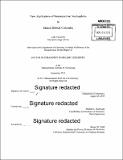New applications of heteroarylzinc nucleophiles
Author(s)
Colombe, James Robert
DownloadFull printable version (15.35Mb)
Other Contributors
Massachusetts Institute of Technology. Department of Chemistry.
Terms of use
Metadata
Show full item recordAbstract
This thesis describes the development and application of chemical methodologies for the use of 2-pyridyl and other aryl and heteroaryl organometallic nucleophiles. Aiming for a practical and effective alternative to 2-pyridylboron reagents, a solid 2-pyridylzinc compound was prepared and is described in Chapter 1. Chapter 2 details a new approach to the synthesis of sulfonamides using aryl and heteroaryl organozine nucleophiles. Chapter 3 describes ongoing collaborative efforts to discover new malaria therapeutics where the synthetic method developed in Chapter 2 facilitated access to targeted compounds. Chapter 1. The Synthesis of a Solid, Air-Stable 2-Pyridylzine Reagent and its Use in Negishi Cross-Coupling Reactions. As an alternative to unstable or unreliable 2-pyridylboron reagents, a solid, air-stable 2- pyridylzinc reagent was developed. Using 1,4-dioxane as an additive enabled a 2-pyridylzinc concentrate as a free-flowing solid that was not deliquescent. The reagent can be manipulated in air and is a competent nucleophile in Negishi cross-coupling reactions. The reagent can also be stored in paraffin wax capsules for significant added stability. Chapter 2. Synthesis of Heteroaryl Sulfonamides from Organozinc Reagents and 2,4,6- Trichlorophenyl Chlorosulfate. A method for the preparation of aryl and heteroaryl sulfonamides using 2,4,6-trichlorophenyl chlorosulfate (TCPC) is described. The reaction of 2-pyridylzinc reagents with TCPC resulted in 2,4,6-trichlorophenyl (TCP) pyridine-2-sulfonates, and the parent pyridine-2-sulfonate was shown to react with amines. Less electron-rich aryl- and heteroarylzinc reagents reacted with TCPC to afford sulfonyl chlorides that were converted in situ to sulfonamides. Chapter 3. Structure-Activity Relationship Studies on Selective Inhibitors of Plasmodium Falciparum Growth. Two classes of compounds that selectively inhibit P. Falciparum were identified by the Lindquist Lab at MIT through the MLPCN compound library and high-throughput screening facilities at the Broad Institute. Using the sulfonamide synthesis methodology described in Chapter 2 and other approaches, analogs of these compounds were prepared and tested using a yeast assay in collaboration with the Lindquist lab at MIT and a P. falciparum assay in collaboration with the Wirth lab at the Harvard T.H. Chan School of Public Health.
Description
Thesis: Ph. D., Massachusetts Institute of Technology, Department of Chemistry, 2015. Cataloged from PDF version of thesis. Includes bibliographical references.
Date issued
2015Department
Massachusetts Institute of Technology. Department of ChemistryPublisher
Massachusetts Institute of Technology
Keywords
Chemistry.